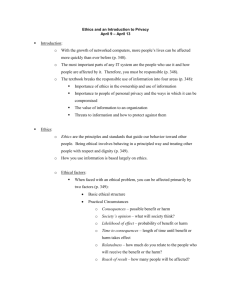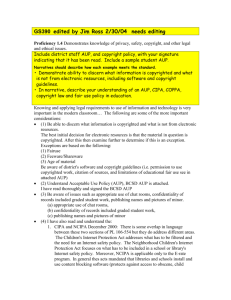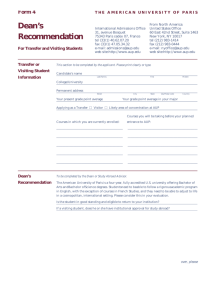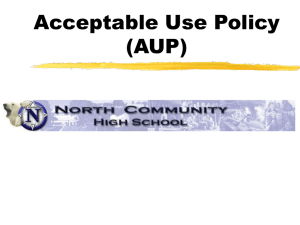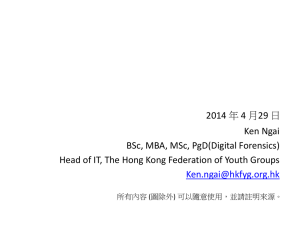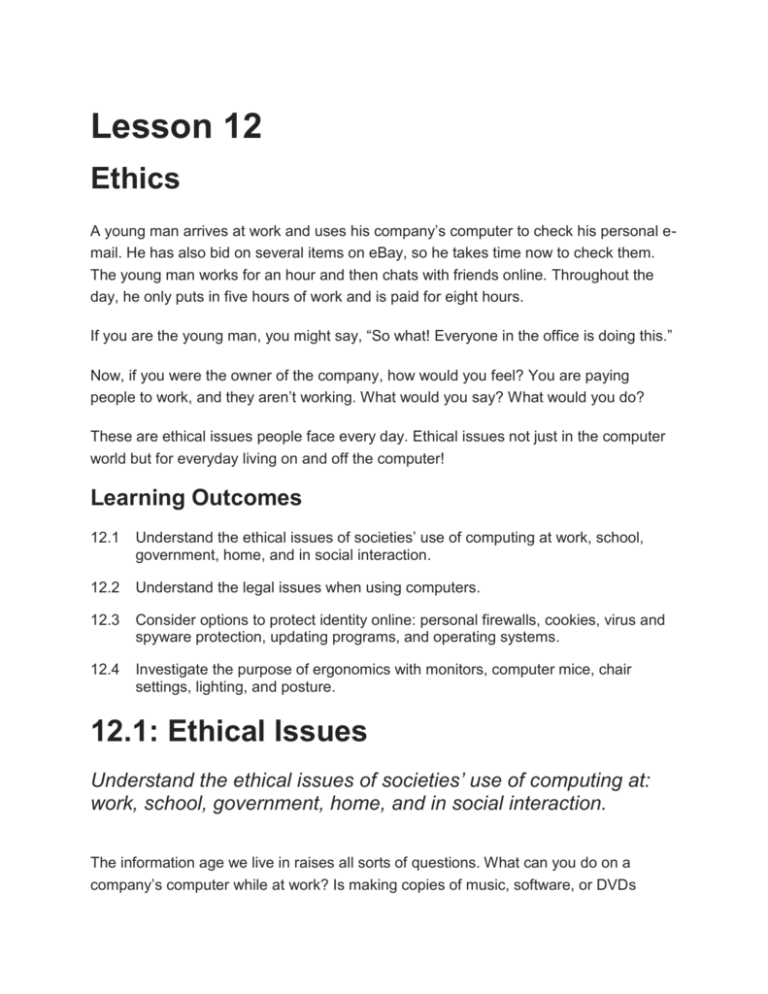
Lesson 12
Ethics
A young man arrives at work and uses his company’s computer to check his personal email. He has also bid on several items on eBay, so he takes time now to check them.
The young man works for an hour and then chats with friends online. Throughout the
day, he only puts in five hours of work and is paid for eight hours.
If you are the young man, you might say, “So what! Everyone in the office is doing this.”
Now, if you were the owner of the company, how would you feel? You are paying
people to work, and they aren’t working. What would you say? What would you do?
These are ethical issues people face every day. Ethical issues not just in the computer
world but for everyday living on and off the computer!
Learning Outcomes
12.1
Understand the ethical issues of societies’ use of computing at work, school,
government, home, and in social interaction.
12.2
Understand the legal issues when using computers.
12.3
Consider options to protect identity online: personal firewalls, cookies, virus and
spyware protection, updating programs, and operating systems.
12.4
Investigate the purpose of ergonomics with monitors, computer mice, chair
settings, lighting, and posture.
12.1: Ethical Issues
Understand the ethical issues of societies’ use of computing at:
work, school, government, home, and in social interaction.
The information age we live in raises all sorts of questions. What can you do on a
company’s computer while at work? Is making copies of music, software, or DVDs
legal? What about school assignments? If someone has posted his or her ideas on the
Internet, does that mean you can use that information any way you want?
Some questions raised in the computer age are an issue of ethics, while others are an
issue of law. Ethics is defined in the dictionary as “a standard of right and wrong; a
system of conduct or behavior, moral principles” (Geddes & Grosset, 2002).It is vital that
you understand both the law and the ethical standards relating to computer use,
because not understanding them can get you in trouble.
Take a look at this scenario:
Two friends go to a music store and they both find a CD they really like. They decide
that to save money, they will split the cost of buying the CD and then just make a copy
so they can both have one.
What do you think is wrong here? Having trouble deciding? You are not alone!
The right decision would be to save your money so both of you could buy your own
copy of the CD.
Rob Pegoraro wrote an article called “Sound Ethics: What to Do with Music CDs after
Ripping Them?” Click on the link below to read the article:
http://voices.washingtonpost.com/fasterforward/2009/03/sound_ethics_what_to_do_with_m.html
As you can see, even adults have trouble making the right decisions!
The right decision for the adults would be to destroy the CDs that are no longer being
used.
Let’s look at another scenario:
A busy college student gets behind in her studies. She is working part time and simply
does not have time to write an English paper that is due the next day. As she is looking
online, she finds an article that goes right along with the topic her professor assigned.
She is able to save hours by simply copying the information and using it word for word
in her paper. She submits the paper without giving credit to the original author.
These three scenarios are examples of either breaking the law or displaying low ethical
standards, the consequences of which can be serious.
Advances in technology force society to consider new legal and ethical questions. This
lesson is designed to help you answer some of the questions that we currently face in
the information age.
12.2: Legal Issues
Understand the legal issues when using computers.
Copyright Laws
The US Constitution grants Congress the power to enact laws that protect the rights of
inventors, musicians, authors, scientists, and so forth. Congress first used this power in
1790 when it passed the first copyright laws designed to protect the rights of those who
wrote books and created maps. The two sets of laws that are the most applicable to us
today are the Copyright Act of 1976 and the Digital Millennium Copyright Act of 1998.
Fig. 12.1. The Constitution allows congress to enact copyright laws. Courtesy of Wikipedia
The Copyright Act of 1976
The Copyright Act of 1976 is a law that protects the intellectual property of others from
being used without permission. Intellectual property is defined as any creative work that
a person develops. It could be the written word, as in a book or magazine article; it can
be visual, as in photographs, paintings, drawings, and sketches; it can be music, as in
CDs and sheet music; or it can be a combination of these, as in movies and plays.
When you buy a book, CD, or DVD there is usually a notice on it that looks like the one
in figure 12.2. Notice the statement “all rights reserved.” This means the owner of the
copyright has the following rights:
1.
2.
3.
4.
5.
6.
the right to reproduce the work
the right to create derivative works based on an original work
the right to distribute (sell, rent, or lease) copies of the work to the public
the right to perform the work publicly
the right to display the work publicly
the right to broadcast the work publicly
Fig. 12.2. Copyright on a DVD case
Think about the scenario where two friends buy one CD and make a copy to save some
money. If you look at the first item in the list, under copyright law you will notice that
copying a CD is illegal.
If a high school wanted to put on a play but not pay the royalty fees, could they just
change the script a little and call it their own work? What if they do not pay the royalty
fees and put the play on for free? Both could be considered illegal. As you can see from
the list above, copyright laws can be violated even if money is not involved.
Why is this important today? Imagine for a moment that you are an aspiring author. You
make many sacrifices, researching and working for years on your first book until it’s
finished. The publisher raves about how great it is and how many copies you will sell.
You think you are going to be rich. However, before it is even on sale, a copy of your
book gets stolen and another company prints it and begins selling it. Now all the money
you were going to bring in is going to someone else who did not even work for it! Would
you be motivated to write another book? Probably not! One purpose of copyright laws is
to help give motivation and financial incentives for people to create music, books, plays,
paintings, and so forth. Knowing their creations will be protected reassures authors and
inventors that they will be given credit for their hard work.
Digital Millennium Copyright Act of 1998
New technologies brought with them new questions about copyright. As music began to
be shared over the Internet, and companies like Napster were created to allow users to
upload and download their favorite music files for free, it became clear that these new
questions needed to be resolved. But since the Copyright Act of 1976 did not cover
music shared over the Internet, Napster and businesses like it were not technically
violating any copyright laws, so they quickly became popular.
At the same time, two new problems caught the attention of the Motion Picture
Association of America (MPAA). While screening first-run movies, unethical people
would secretly record the movie. These illegally made copies were then placed on the
Internet for anyone to download and watch free of charge.
The other problem the MPAA detected was that encryption codes on commercially
distributed DVDs had been cracked. Encryption codes are small software programs at
the beginning of music CDs and movie DVDs that prevent people from copying the
media. Encryption did not work because people were able to create software programs
to crack and disable the encryption codes.
Finally, computer software companies, such as Microsoft, noticed that their software
CDs were being copied and distributed without permission. Because the Copyright Act
of 1976 did not include these issues, they had no way to protect their products legally or
to take offenders to court for stealing their products.
This free flow of traditionally copyrighted materials cost software companies, artists, and
producers millions of dollars. Questions were raised: Who owned the work put out on
the Internet? Was anyone in violation of copyright laws? If so, was it the person who
uploaded the file, the person or company who stored the file, or the person who
downloaded the file? Did the Copyright Act even apply to intellectual property placed on
the Internet?
Companies needed the law to be changed in order to continue making a profit from their
copyrighted material, so they worked to help lawmakers create what became the Digital
Millennium Copyright Act. This law defines more clearly that the rights of copyright
holders extend to the Internet. It also put in place stiff penalties for violations of these
laws. For example, downloading copyrighted material from peer-to-peer networks can
now result in fines ranging from $30,000 to $150,000.1 (Copyright.gov) The Digital
Millennium Copyright Act also made it illegal to bypass encryption codes and to
distribute software designed to crack security codes on CDs, DVDs, and software.
As a result of the new law, the courts ordered Napster to remove all copyrighted songs
in their databases. Since then, Napster (now part of Rhapsody), Pandora, and other
businesses like it can only distribute media over the Internet for a fee. This fee is then
paid to the recording artists.
Fig. 12.3. The Fair Use Act allows people to use small portions of
other's work without violating copyright.
The Fair Use Act
I have a dream that one day this nation will rise up
and live out the true meaning of its creed: “We
hold these truths to be self-evident: that all men
are created equal” (King, 1963)
Great men and women say many profound things.
How sad it would be if we only heard great things
once. As you write research papers and
speeches, quoting someone as powerful as Dr.
King can add substance and interest to your work.
The Fair Use Act is a law that allows people to use small portions of someone else’s
work for the purposes of “criticism, comment, news reporting, teaching, scholarship, and
research” (Copyright.gov, 2015.) Teachers and students frequently apply the Fair Use
Act when reproducing a small part of a work to illustrate a lesson or assignment. This
use is not an infringement of copyright as long as the quote or idea is appropriately
cited. The doctrine of fair use applies if the material quoted is being used for nonprofit
purposes and if only a small portion of the work is used. Additionally, the use of the
material cannot affect the ability of the copyright owner to market the material. 3
Not all intellectual property has a copyright on it. In some cases, individuals and
businesses choose to allow more access to their materials than traditional copyrights
would allow. These different options are discussed below.
Freeware
Freeware is classified as software that is distributed for free and that can be used as
long as you want. However, there are some limitations about how freeware can be
used, which vary from program to program. Some popular examples of freeware include
Mozilla Firefox, iTunes, and Windows Live Messenger.
Shareware
Unlike freeware, shareware is only temporarily free. A creator of shareware will allow
you to use the software free of charge for a trial period, such as thirty days. After the
trial period, you are asked to pay for the software if you want to keep using it. Most
shareware will stop working after the trial period. This is done to encourage you to buy
the software. Many computer games are offered in shareware versions so you can try
them out before buying them.
Public Domain
Intellectual property that is not protected by copyright law is considered to be “in the
public domain,” which means that anyone may use it. Copyright law only protects works
for seventy years after the death of their creator, so work that was done before 1945 is
now available to anyone. More recent work also enters public domain if it is published
by the US government or if the creator cannot prove that he or she created the material
and when it was created. You must always give credit to the sources of works you use,
even if the work is in the public domain.
Open Source
When the Microsoft Windows operating system came on the scene, there were no
programs available to run on Windows. Microsoft had to publish some of its operating
system code as an open source. This allowed collaborating groups (other companies) to
use that source code to develop application software to run on Windows. This is still
how other companies develop computer games that run in Windows. There are many
examples of open source work, but the common definition is that it is code shared for
the purpose of collaborating on software projects. This idea has now expanded to sites
like Wikipedia that are the result of many people contributing information to a single
project.
Employee Productivity
As helpful as computers and technology may be, they also bring with them some
serious challenges for businesses. For example, increased access to the Internet and
all of the diversions it offers has hurt the productivity of some businesses. Work
productivity decreases during big events, such as the Olympics, Christmastime, the
presidential election, and so on because workers easily get distracted and surf the
Internet.
Remember the story at the beginning of this lesson about the young man who spent his
work time playing on the Internet? Unfortunately, that scenario has become very
common in the work place. At Christmastime, employees spend a lot of time shopping
for Christmas gifts online; during the Super Bowl, employee productivity drops to an alltime low as seen in the headlines below; just before Valentine’s Day, employees often
order candy and flowers from their computers at work. All this adds up to lost
productivity, or in other words, lost money for a company.
Check out this article from the Orlando Business Journal called “How much productivity
is really lost the Monday after Super Bowl? It is written by Megan Ribbens and dated
February 4, 2013:
http://www.bizjournals.com/orlando/morning_call/2013/02/how-much-productivity-is-really-lost.html
Company Resources
Resources are the consumable goods that a company needs to function, such as paper,
printer toner (ink), copy machine paper, copier ink, paper clips, pencils, and tape. These
are just a few of the resources lost each year as a result of employee theft.
Stolen paper clips might not seem like a serious problem, but let’s say that your
company has fifty employees. Each week forty employees take a pencil home. Some
employees take the pencil because they think the company owes it to them. Some
employees take the pencil home by mistake. At any rate, forty pencils go missing each
week. Over the course of a year this begins to add up:
40 pencils × 52 weeks = 2,080 pencils per year
That’s a lot of pencils!
Now add a similar loss of paper, toner, photocopies, paper clips, sticky notes, and so on
and very soon the dollar amount lost is staggering.
Also remember that company resources include the computer systems, like e-mail and
Internet access. Surfing the Internet for pornography, online gambling, online games,
chatting, and online dating during company time takes an employee away from his or
her work and can tie up the company’s resources and prevent others from being able to
complete their work.
Piracy
Piracy is the unauthorized and illegal reproduction,
sale, and distribution of any copyrighted work. In
some cases, a company could be held legally
responsible if one of its employees used company
resources for piracy.
Hacking
Hacking is breaking into another person’s or
another company’s computer system. In the world today, ideas and information can
mean big money. If an unethical employee steals those ideas or information, the
company can suffer financially.
Each year a news story appears where a student
hacked into a university’s computer system to
change his or her grades. This is illegal!
Consequences range from getting kicked out of
school (expelled) to going to jail and paying
restitution (money).
Acceptable Use Policies
As a good student, employee, and citizen, you will be expected to maintain a high code
of ethics as you use technology. Remember that ethics are defined as “a standard of
right and wrong; a system of conduct or behavior, moral principles.” Schools and
companies almost always set the ethical standards and policies for their organization by
creating some form of an Acceptable Use Policy (AUP). In most places that you work
or before you are given access to any kind of computer system, you are required to sign
an AUP.
This policy is a guideline or code of conduct for
students or employees. Simply stated, the policy is a
list of rules of what you can and cannot do with school or company resources. Although
your teacher may not have called it an acceptable use policy, you have probably seen
one. Teachers often present a disclosure document or a syllabus at the beginning of
class each semester which details the rules and the grading methods for the course.
This is one form of an AUP.
This sample AUP shows my rules for computer use in my classroom.
No pornography.
No gambling.
No online shopping, selling, trading, or dating.
No Internet surfing unless it is part of a specific learning assignment.
No music or music videos at any time.
No games unless they are part of a specific learning assignment such as learning
to create software called programming.
No personal e-mail such as Yahoo, Hotmail, AOL mail, etc.
Although each organization has its own specific set of standards and policies, there are
usually some common elements to an AUP.
1. a general statement about the purpose of providing access to the computer
network or to the Internet
2. a statement about etiquette (called netiquette) on the Internet and e-mail; policies
about being courteous in communications, avoiding illegal online activities, not
using the system for personal activities, and so forth
3. a section that emphasizes the importance of not violating copyright law
4. a statement about the consequences of violating the AUP; depending on the
organization, consequences may range from suspension of computer privileges
to expulsion from school or being fired from a job
The AUP protects the student or employee and also the school or company. One way it
does this is by making the rules clear and fair for everyone.
Some companies do not mind if employees use their computers for personal use, and in
other companies it is a serious offense. One role of an AUP is to clearly state what can
and cannot be done with company resources. This helps students and employees
because they are not left wondering what is and is not allowed.
Fig. 12.4. Excerpt from the Bill of Rights
Privacy
How does the amendment above apply today? Could a company that tracks your
shopping habits be violating your rights? How do privacy rights apply at school and
work? When discussing privacy, we are actually talking about two issues; privacy at
home, and privacy at work and school.
Privacy at Home
You have the right to keep certain types of
personal information about yourself private. One
example is your finances. When you go to your
family doctor, you do not want him to know
exactly how much money you have in your bank
account before he will treat you. What if you do
not have enough money to pay for his services?
When you apply for a job, you may not want your
future employer to know that you race
motorcycles on weekends. What if your future employer thinks this activity will cause
injuries that will prevent you from coming to work and therefore does not hire you? This
type of personal information is protected by law and you are not required to reveal it.
But not all information about you is protected. When you shop online at Walmart for
example, Target may end up knowing what you bought. Every day, data is collected
about our surfing habits, shopping habits, eating habits, and so forth. Most of this data is
collected without our knowledge. This is called consumer profiling. There is nothing you
can do legally to stop people from collecting this type of information about you. Their
right to collect data is protected under the First Amendment.
Privacy at Work and School
Suppose it is after work hours and you decide to stay late and surf the Internet, maybe
do a little shopping, put something up for sale on eBay, chat with friends, and check an
online dating website. Your company’s AUP states that doing this is against policy, but
it’s after hours, and you figure no one will know. The next day you are called into your
boss’s office and given a warning. How did your boss know, and isn’t this a violation of
your privacy since it was after hours?
On your own computer at home, you can do those types of things, but it is a different
story at work. As discussed above, the loss of
productivity due to employees using the Internet
for personal reasons is staggering and costly.
Schools and businesses could also face legal
action if you get into pornography or commit a
crime using company or school resources.
“That’s not fair,” you say. You don’t get into any
of those things. The AUP makes the rules fair for
everyone by insisting that everyone follows the rules. And since the computer
equipment is owned by the company, the company has the right to set the rules. The
employees don’t!
Monitoring
The Bill of Rights does not prevent an employer from keeping tabs on what employees
are up to. Employers can monitor telephone calls, e-mail usage (both company e-mail
and private e-mail if you access your private email using company equipment), what is
on your computer screen, and the documents you create. Deleting your personal emails, phone messages, or Internet history does not always mean they are not available
to your employer or school administrator. Employers can monitor employees through
electronic devices, cameras, and sound equipment. They are also able to restore
deleted items if they need to and use network services to trace where you have been
online. Being monitored helps employees and students stay on task. Remember that
whether you are at school or work, almost nothing is private!
Cookies
One way information is gathered about you is through something called cookies. This is
a small software program that is installed on your computer through the Internet. Most
of the time, you do not even know that it is there. It sits quietly working, tracking your
every move. Data is gathered about where you work, how much you earn, traffic tickets
you receive, your education, insurance, property ownership, medical and hospital
information, where you bank, your family history, your favorite hobby or sport, and so
much more. This data is then sold to others who use it to send you junk mail, increase
the number of pop-ups you see when browsing the Internet, or send you to web pages
you really did not want to go to. Whether or not this is legal depends on the types of
information being gathered and also the reasons, or intentions, for which it will be used.
It is quite possible to have hundreds of cookies on your computer. One or more from
every website you have visited.
Intent
The question of whether or not collecting data is legal comes down to intent. How will
your personal data be used? If the intent is to try to sell you something, or to sell your
information to someone else, then collecting your personal data is legal. However, if the
intent of data collection is to steal your identity or some other malicious intent, then
personal data collection is illegal.
12.3: Identity Theft
Consider options to protect identity online: personal
firewalls, cookies, virus and spyware protection, updating
programs, and operating systems.
You are identified not only by your first,
middle, and last name, but also by your
social security number. This is a number
that was assigned to you shortly after
your birth.
Your social security number is very valuable and should be protected. Do not give your
social security number to just anyone. If someone asks you for your social security
number, talk to your parents and let them help you make the decision about giving your
number out.
There are a number of ways your identity can be stolen. By stealing your bank account
or credit card numbers, people can spend money in your name and leave you to pay the
bill. Information about you can be found on bank statements, credit card applications,
medical bills, and other mail that has been sent to you.
An additional danger comes in the form of “free” offers. These often appear in small
windows known as pop-ups. These free offers promise everything from ringtones to a
trip on a cruise ship but require you to buy several other products to receive your “free”
gift. Even when you buy these other products, companies often make it difficult to claim
your prize. The danger here comes when they are not interested in the money from
having you buy their products, but they really just want your personal information.
This is a perfect setup to take your personal information since in a business transaction,
you are often asked to reveal personal information such as your name, address, phone
number, and credit card number. Remember, do your online shopping only on secure
websites.
What steps can you take to prevent identity theft?
1. Guard your personal information such as your social security number and
medical insurance information. Keep cards with these numbers on them in a safe
place.
2. Before throwing away documents with your personal information on them, use a
paper shredder to shred the documents.
3. Use passwords on all your accounts, including your credit card accounts, and
your bank and phone accounts. Experts advise that to be truly secure, a
password should be unpredictable and never written down. For computer
passwords, many recommend a minimum of eight characters, with at least one
capital letter, one number, and one symbol. Use the password tips you used in
lesson 4.
4. Memorize your computer logins and do not share them with others.
5. Memorize your PINs and passwords to bank accounts and ATM machines. Do
not carry them in your purse or wallet.
6. When shopping online, use a secure website. As you are submitting your
purchase information, look for a lock icon on the browser’s status bar to ensure
the information you provide is secure during transmission. This is a computer
industry standard indicating the website is a secure site for using your credit
card. If you do not see the lock, check the URL box. If the address begins with
https://, it is a secure website. The s in the http indicates that your information will
be encrypted before sending it on the Internet. Remember, the encryption means
that the information is broken up and coded before sending. Anyone intercepting
the packet of information will not be able to read the coded information. Only the
authorized receiving computer can remove the encryption and put the information
together into readable form again.
7. Avoid scams where you receive unsolicited e-mail asking for your personal
information. This is known as phishing.
There are many websites with excellent information on how to prevent identity theft. I
have given you the URLs for some that I think are very good. However, no one is 100
percent safe these days. Learn what to watch for and stay vigilant!
And remember, websites move or are removed from the Internet. So if these links do
not work, use your search skills to find other articles.
How to Prevent Identity Theft
http://creditidentitysafe.com/identity-theft-prevention
How to Prevent Identity Theft
http://www.wikihow.com/Prevent-Identity-Theft
Steps to Prevent Identity Theft, and What to Do If It Happens
http://www.nytimes.com/2009/05/02/your-money/identitytheft/02idtheftprimer.html?pagewanted=all&_r=0
How to Prevent Identity Theft
http://www.cbsnews.com/news/how-to-prevent-identity-theft/

